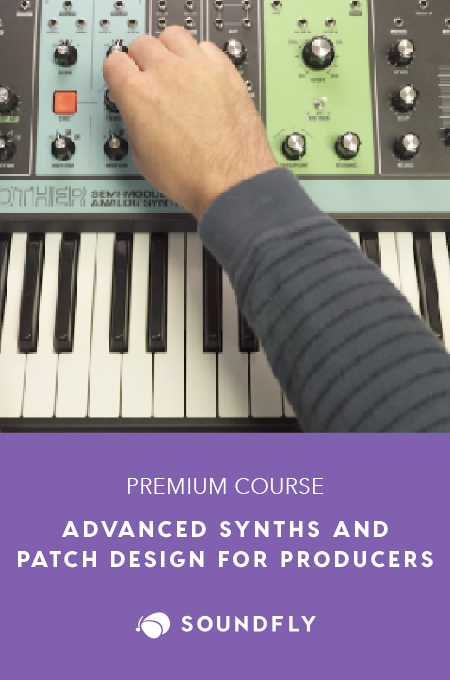
+ This is an excerpt from Soundfly’s Advanced Synths and Patch Design for Producers. To access the rest of this lesson, plus hundreds of instructional videos and tutorials on production, songwriting, composing, mixing and more, subscribe here.
Different disciplines have their own languages.
If you open up a string library, you’ll encounter things like col legnos, sul tastos, pizzicatos, sul pont, etc. If making that kind of music is important to you, you’ll internalize what those mean, and what they sound like. That way, you can listen to a piece of music and say, “man, those col legnos in the double bass sound super menacing!” and start to make informed decisions about accessing a sort of menacing sound in your compositions.
Synths are not that different! We can turn descriptors like “wobbly” and “seething” into meaningful patching decisions when we relate those words to different kinds of modulation, methods of synthesis, and parameters.
Bright vs. Dark
This one might be pretty obvious, but think about walking outside on a sunny day without sunglasses. A bright sound is harsh — think about a raw saw wave with the filter wide open. Check out the lead sounds in the middle of this massive remix of M83’s hit, “Midnight City” (around 2:17 or so).
When you roll that low-pass filter cutoff down, you start accessing a darker tone, like the bass sound in “Look to the Skies” by Calyx and TeeBee.
Warm vs. Cold
We tend to say a sound is warm when it’s harmonically rich and dark. However, it could also describe the sort of hug your ears get from a big analog polyphonic synth, or even a mono patch with some creative unison settings — think about how bass sounds are often described as warm, like in this huge, lush bass sound in Little Dragon’s “A New” (around 0:48).
Cold sounds tend to be pure, higher in pitch — think the delicate icy sine waves in Trentemøller’s “Miss You.” Certain methods of synthesis really excel at these kinds of patches. FM synthesis in particular uses sine waves as the basic building block for its sounds and allows you to create unique harmonics that would be really tough to mimic anywhere else in nature.
Narrow vs. Wide
Narrow sounds are often mono (one channel, not necessarily monophonic!), or have a clearly defined position in the mix. Many older analog synths had a single output. In fact, many hardware modern synths do, too! However, if we relate it to strings for a second, a sound that’s narrow may also sound like a soloist, rather than a section.
For example, check out the opening modular-type synth sound in Björk’s “Arisen My Senses.”
If you kept listening past the first few bars, you heard the track explode in to a vast stereo expanse! Wide sounds tend to have that sort of sectional quality to them — they sound like a chorus of instruments playing the same thing, filling out space and imparting some natural randomness and dimension to the sound.
Unison settings on synths are often the source of this, but it can also come from post-processing decisions like adding a chorus effect. Nothing like a massive Andrew Bayer track to feel like the expanse of the universe is contained within a single synth patch…
Evolving vs. Stationary
One of the best ways to think on the signal level is to identify the things that are changing over time. If the sound gains brightness over the course of a note, is it the filter? What’s controlling the filter to make it behave the same way on each note? If it’s not the filter, what else could be evolving?
In Datsik’s “Nasty,” there’s plenty of evolution to decipher…
Simultaneously, recognizing what’s stationary is equally important. For instance, if the pitch isn’t wobbling, you can make a guess that there isn’t any kind of vibrato type modulation. When oscillators are really stable and well-tuned to each other, they rip through busier mixes with ease, like in the Notorious B.I.G. classic, “Big Poppa.”
+ Read more on Flypaper: “Emulating Boards of Canada’s Classic Synth Sound Without Breaking Your Bank (or Brain).”
Beating (Detuning) vs. Vibrato
Detuned oscillators have a sort of beating, unison-esque quality to them. This can add to the sort of thickness or relative sort of analog-iness of a sound. They sound kind of smeary and wonderful. They’re all over this groovy track from the Black Panther soundtrack by SZA and Kendrick Lamar, called “All The Stars.”
Vibrato is that semi-operatic, periodic rising and falling of pitch. When static and subtle, it adds interesting movement to a sustained part. When heavy, it’s often more temporary, like in a synth solo or lead. A great example is the opening lead sound from the MGMT hit, “Kids” (listen to the last note of the melody).
Wobbly vs. Consistent
“Wobble” gets thrown around a lot when we discuss synth sounds. In our opinion, it tends to most often refer to a kind of dynamic modulation where a sound goes from sounding less, to more modulated. Think of a bass patch where the filter cutoff is modulated by the LFO, but the rate of the LFO changes over time, making the sound more dramatic. Kind of like a pot of water boiling, then calming and boiling again.
Or, for a more extreme example, consider the opener of the recent Floating Points record, “Falaise,” where he had musicians play — almost as if they were the oscillators — then sent it through a Buchla synth, where there was (In his own words, from this Resident Advisor interview):
“…an envelope generator opening and closing lowpass gates. Changing the attack time of the envelope makes it feel like sounds are happening backwards. I did a pass changing the envelope shapes in real-time while the musicians were playing.”
On the other hand, consistent tones and articulations can be incredibly effective, especially when arranged as effectively as all the synth patches in Tyler, the Creator’s “EARFQUAKE.”
Sliding vs. Repetitive
Portamento and legato articulations help tie notes together in a way that can really closely imitate a vocalization of a part. It can also help a patch sound eerie and dark as anything, like in this dirty, dark beat by Vince Staples, “Norf Norf.”
Having notes separated helps to create patches that feel more like accompaniment instruments like keyboards and guitars, like the plucky opening lead in “Saturnz Barz,” by Gorillaz. (Also, by contrast, note the heavy portamento on the contrapuntal lead in the middle of the verse!)
There are, of course, myriad ways to describe the nearly infinite realm of synth timbres, tones, and articulations. These are simply good places to start when listening to your favorite synth patches, in order to decipher how to recreate the sound yourself!
Ready for more?
Continue learning about synthesis and patch design with Soundfly’s exciting new course, Advanced Synths and Patch Design for Producers. Preview the course for free, and subscribe for access here.




